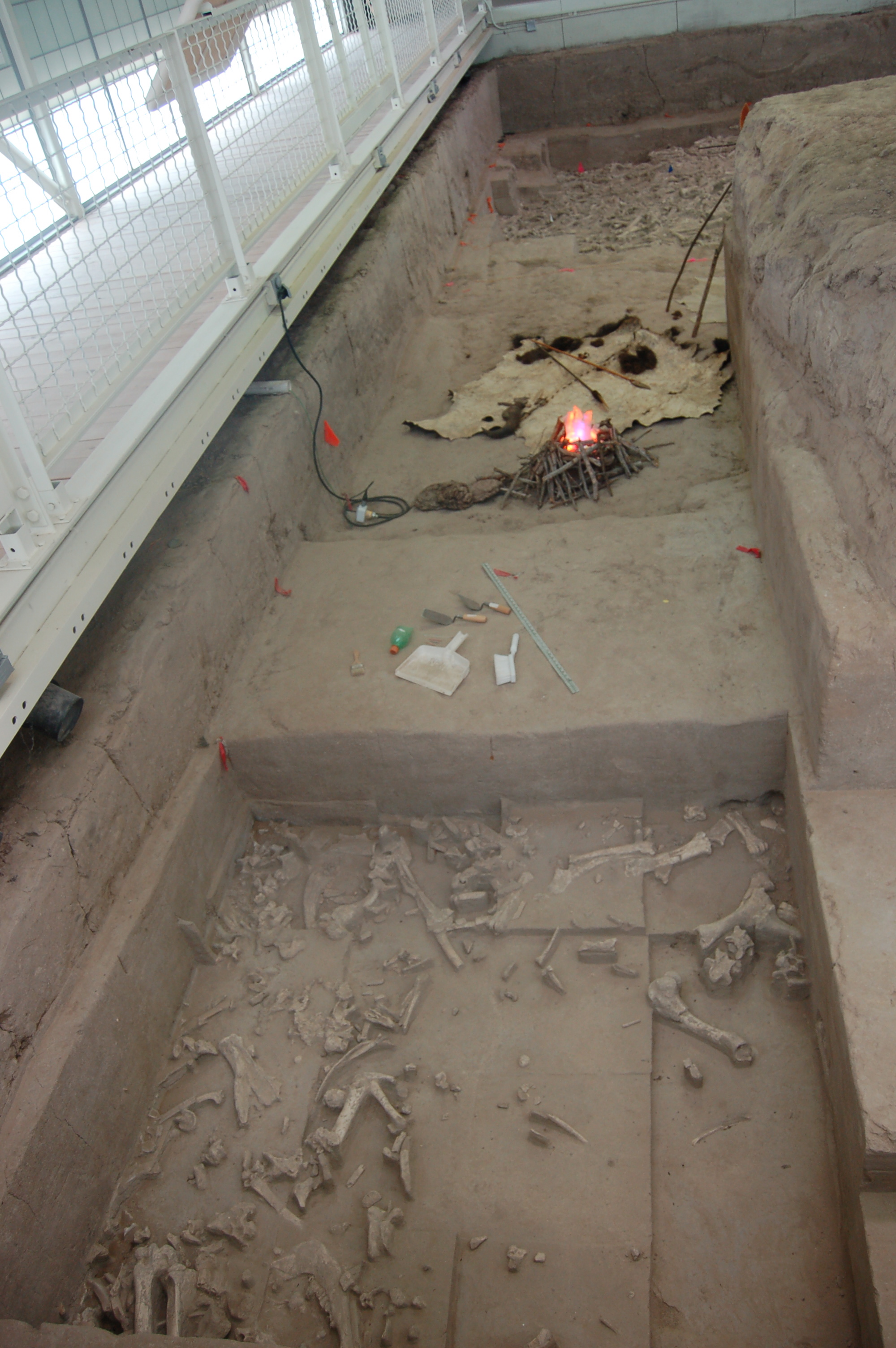Hudson-Meng Bison Kill on:
[Wikipedia]
[Google]
[Amazon]
The Hudson-Meng Bison Bonebed site, officially named the Hudson-Meng Education and Research Center, is a fossil site located in the Oglala National Grassland of Fossil Freeway.
Retrieved 2010-10-31.
Open seasonally, the site features a visitor center with interpretive exhibits and views of the bones. Guided tours are available.
The Bison Trail to 
Hudson-Meng Education & Research Center
- US Forest Service
* ttps://archive.today/20121211160544/http://lamar.colostate.edu/~lctodd/hmsmry.htm Summary of Recent Fieldwork at the Hudson-Meng Site- by L. C. Todd and D. J. Rapson, 1991–1998 {{authority control Archaeological sites on the National Register of Historic Places in Nebraska Cenozoic paleontological sites of North America Federal lands in Nebraska Pre-statehood history of Nebraska Museums in Sioux County, Nebraska Natural history museums in Nebraska Buffalo jumps Paleontology in Nebraska United States Forest Service protected areas Protected areas of Sioux County, Nebraska National Register of Historic Places in Sioux County, Nebraska Fossil parks in the United States
Sioux County, Nebraska
Sioux County is a county in the U.S. state of Nebraska. As of the 2010 United States Census, the population was 1,311. Its county seat is Harrison.
Sioux County is included in the Scottsbluff, NE Micropolitan Statistical Area.
In the Nebrask ...
20 miles northwest of Crawford. It contains the 10,000-year-old remains of up to 600 bison
Bison are large bovines in the genus ''Bison'' (Greek: "wild ox" (bison)) within the tribe Bovini. Two extant and numerous extinct species are recognised.
Of the two surviving species, the American bison, ''B. bison'', found only in North ...
."Hudson-Meng Bison Bonebed".Retrieved 2010-10-31.
Toadstool Geologic Park
Toadstool Geologic Park is located in the Oglala National Grassland in far northwestern Nebraska. It is operated by the United States Forest Service. It contains a badlands landscape and a reconstructed sod house. The park is named after its ...
is a 3-mile hike.
History
Bill Hudson and Albert Meng were local ranchers who are credited with discovering the bonebed in 1954 while digging for a pond. Originally excavated by Dr. Larry Agenbroad in the 1970s, the dig was over 400 square meters and was considered the largest Alberta Culture bison kill site ever discovered. The bison found are not the same species as the bison that currently live in the United States (''Bison bison
The American bison (''Bison bison'') is a species of bison native to North America. Sometimes colloquially referred to as American buffalo or simply buffalo (a different clade of bovine), it is one of two extant species of bison, alongside the ...
''), but are an animal transitional in evolution between the extinct '' Bison antiquus'' and the modern species.
In the 1990s, the site underwent another series of excavations by Drs. Larry Todd of Colorado State University and David Rapson of the University of Wyoming
The University of Wyoming (UW) is a public land-grant research university in Laramie, Wyoming. It was founded in March 1886, four years before the territory was admitted as the 44th state, and opened in September 1887. The University of Wyomin ...
, who determined that the bison died of unknown natural causes and that the site was not in fact a kill site.
In 2005, PaleoCultural Research Group and the University of Colorado
The University of Colorado (CU) is a system of public universities in Colorado. It consists of four institutions: University of Colorado Boulder, University of Colorado Colorado Springs, University of Colorado Denver, and the University o ...
undertook excavations at the site. In 2006, the USFS made Dr. Mark Muñiz of St. Cloud State University
St. Cloud State University (SCSU) is a public university in St. Cloud, Minnesota. Founded in 1869, the university is one of the largest institutions in the Minnesota State Colleges and Universities system. Its enrollment in 2020 was approximately ...
the principal investigator for archeological research. The research since 2006 has uncovered an Eden component at the site in addition to the Alberta component.
The site was managed for two years by The Mammoth Site of Hot Springs, South Dakota
Hot Springs ( Lakota: ''mni kȟáta''; "hot water") is a city in and county seat of Fall River County, South Dakota, United States. As of the 2020 census, the city population was 3,395. In addition, neighboring Oglala Lakota County contracts the ...
under the supervision of the United States Forest Service
The United States Forest Service (USFS) is an agency of the U.S. Department of Agriculture that administers the nation's 154 national forests and 20 national grasslands. The Forest Service manages of land. Major divisions of the agency inc ...
. As of 2009, the site is managed by the US Forest Service out of Chadron, Nebraska
Chadron ( ) is a city and the county seat of Dawes County, in the state of Nebraska in the Great Plains region of the United States. The population was 5,851 at the 2010 census. This city is the location of Chadron State College.
Chadron also ...
.
References
External links
Hudson-Meng Education & Research Center
- US Forest Service
* ttps://archive.today/20121211160544/http://lamar.colostate.edu/~lctodd/hmsmry.htm Summary of Recent Fieldwork at the Hudson-Meng Site- by L. C. Todd and D. J. Rapson, 1991–1998 {{authority control Archaeological sites on the National Register of Historic Places in Nebraska Cenozoic paleontological sites of North America Federal lands in Nebraska Pre-statehood history of Nebraska Museums in Sioux County, Nebraska Natural history museums in Nebraska Buffalo jumps Paleontology in Nebraska United States Forest Service protected areas Protected areas of Sioux County, Nebraska National Register of Historic Places in Sioux County, Nebraska Fossil parks in the United States